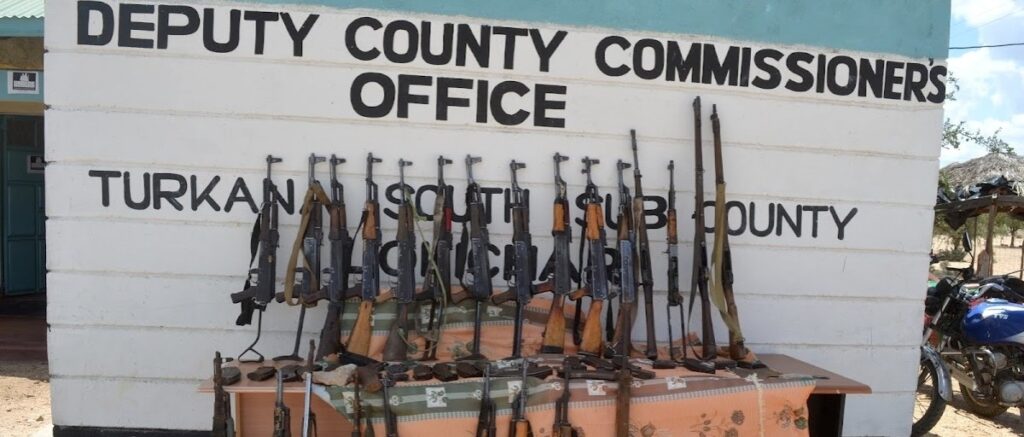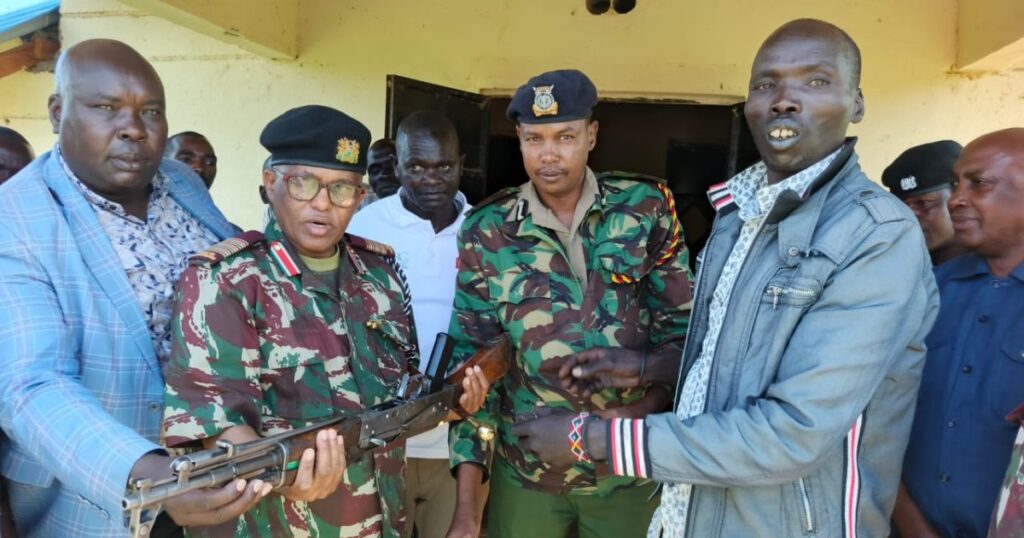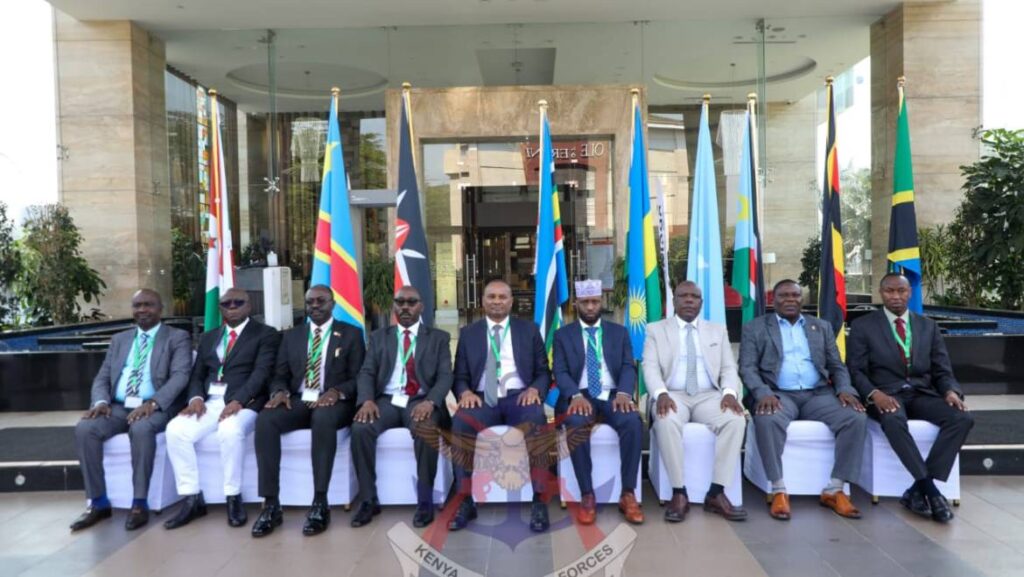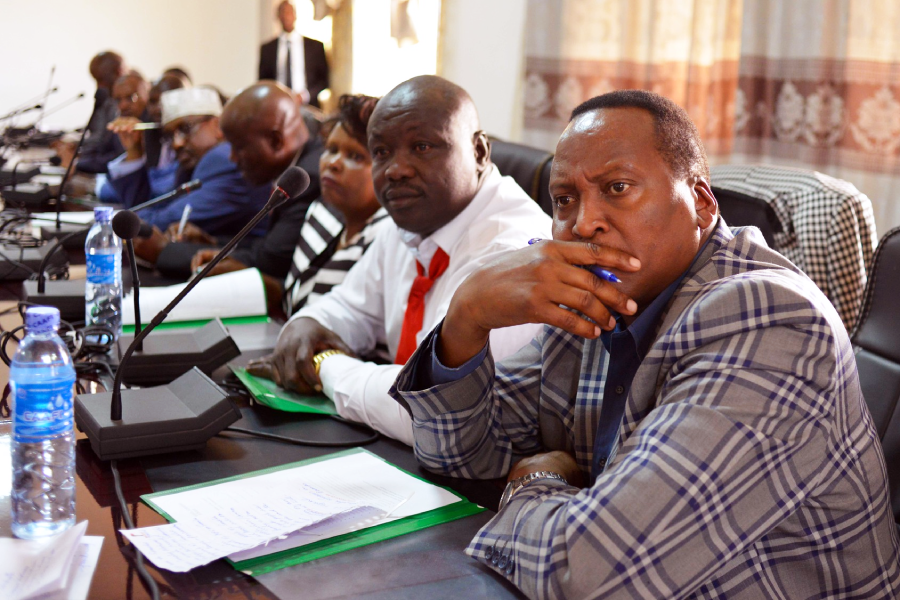
1.0 Introduction
The ongoing voluntary surrender of illegal firearms in Elgeyo Marakwet County in Kenya marks a significant turning point in the country’s historically volatile North Rift, a region long associated with banditry, cattle raids, intercommunal conflicts, and insecurity. Between August and October 2025, over 250 firearms, including AK-47s and G3 rifles, were handed in under a government-backed amnesty (Kenya Ministry of Interior, 2025). This initiative reflects growing trust between communities and state institutions, reinforced by inclusive forums such as Jukwaa la Usalama and incentive programs that reward compliance, including cash-for-arms schemes, livelihood support, and community recognition. It is part of Operation Maliza Uhalifu North Rift, launched in 2023 as a multi-agency strategy combining the Kenya Defense Forces and the National Police Service to restore order across Elgeyo Marakwet, Baringo, Turkana, Samburu, and West Pokot counties (Republic of Kenya, 2024). By emphasizing dialogue over coercion, voluntary surrender illustrates that trust-building, visible security presence, and responsive governance can produce measurable results. Regionally, similar disarmament initiatives have been pursued in South Sudan’s Jonglei State, Ethiopia’s Afar region, Rwanda, and Tanzania’s Manyara region, integrating livelihood support, community policing, and development incentives (UNDP, 2024; Small Arms Survey, 2023; UNODC, 2024). Situated within the Eastern Africa small-arms belt, Elgeyo Marakwet’s experience provides valuable insights into how pastoralist and frontier communities can engage constructively with state authorities. This commentary analyzes the drivers, challenges, and policy implications of voluntary firearm surrender, offering a regional security foresight perspective and informing strategies for sustainable peace, cross-border cooperation, and anticipatory conflict prevention across Eastern Africa.
2. 0 Key Issues
2.1 Historical Disarmament Fatigue

Past disarmament campaigns in Kenya’s North Rift, including Operation Dumisha Amani (2011) and Usalama Watch (2014), often failed due to punitive enforcement, selective targeting, and community mistrust (Small Arms Survey, 2022). Villages left unprotected or excluded perceived disarmament as politically motivated, resulting in rearmament cycles. Lessons from these failures informed Elgeyo Marakwet’s inclusive amnesty, where elders, local leaders, and community representatives mediated firearm surrender. Similarly, Uganda’s Karamoja sub-region experienced early coercive failures, later improved through dialogue-led interventions under the Karamoja Integrated Disarmament and Development Program (Small Arms Survey, 2022). In Burundi, post-election localized dialogue facilitated arms returns, and Djibouti’s cross-border discussions encouraged voluntary compliance among nomadic populations. Verified data indicate a 45% reduction in firearm-related incidents in Elgeyo Marakwet from January to September 2025 (National Police Service, 2025). These approaches highlight that acknowledging historical grievances, combined with trust-building interventions will promote tangible peace dividends in Eastern Africa.
2.2 Socioeconomic Triggers and Livelihood Insecurity
Economic vulnerability is a key driver of firearm possession in pastoralist communities across Kenya’s North Rift. Approximately 58% of households rely on livestock, yet droughts, resource scarcity, and cattle raids weaken household resilience (KNBS, 2024). Firearms often serve as protective tools and social identity markers. The voluntary surrender initiative aligns with Operation Maliza Uhalifu interventions, including market rehabilitation, school renovations, road improvements, and increased policing (Republic of Kenya, 2025). Regional parallels include livelihood-linked disarmament in Somalia’s Puntland, Ethiopia’s Somali region, and Tanzania’s Manyara pastoralist zones, where incentives such as livestock restocking, vocational training, and agricultural inputs reduced armed engagement (UNDP, 2023; RECSA, 2023). Linking disarmament with tangible economic benefits makes compliance rational and socially rewarding, enhancing the legitimacy of state interventions. Sustained investment in climate-resilient livelihoods and youth employment is essential to prevent relapse into armed banditry, demonstrating that voluntary disarmament programs must integrate socioeconomic resilience for long-term stability.
2.3 Cross-Border Arms Circulation and Regional Dynamics
Elgeyo Marakwet lies within the Eastern Africa small-arms corridor, stretching from South Sudan through Ethiopia into northern Kenya. UNODC (2024) estimates 60–70% of illicit firearms in Kenya originate from neighboring countries affected by conflict and weak governance. Cross-border arms circulation complicates national disarmament, leaving disarmed communities vulnerable if neighboring regions remain armed. Coordinated initiatives along Kenya–South Sudan and Ethiopia–Kenya borders, including synchronized amnesty windows, intelligence-sharing, and joint patrols, reduce illicit flows and enhance compliance (RECSA, 2023). Regional frameworks such as IGAD CEWARN and RECSA provide platforms for harmonized amnesty schedules, intelligence coordination, and conflict early-warning dissemination. Similar cross-border dialogues in Sudan’s Blue Nile region, Uganda’s West Nile, and Rwanda’s Akagera corridor demonstrate that synchronized, transparent interventions prevent displacement of violence, build community trust, and produce sustainable security outcomes. Leveraging these regional mechanisms ensures that voluntary surrender in Elgeyo Marakwet contributes to broader stability across Eastern Africa.
2.4 Trust-Building and Security Governance
Trust between communities and security agencies is central to durable voluntary disarmament in Kenya’s North Rift. Historically, state forces were perceived as punitive, reducing compliance and discouraging firearm surrender. Recent initiatives that emphasize on dialogue, participatory oversight, and amnesty assurances, is gradually shifting perceptions and encouraging ex-combatant engagement in local peacebuilding initiatives. In Uganda’s Karamoja sub-region, Ethiopia’s Afar region, Rwanda, and Djibouti elders, local councils, and community monitors have been integrated into oversight of firearm surrender, enhancing credibility and acceptance (Small Arms Survey, 2022; UNDP, 2023). Maintaining trust requires transparency, predictability, and accountability in enforcement, reinforced by community policing committees, structured informant programs, and conflict-sensitive policing. Rights-based oversight ensures that surrender is safe, dignified, and socially valued. Embedding trust and accountability consolidates compliance, strengthens institutional legitimacy, and provides a replicable model for sustainable voluntary disarmament across fragile pastoralist and border regions, contributing to long-term stability, inclusive governance, and community-owned security throughout Eastern Africa.
3.0 Conclusion

The voluntary surrender of firearms in Elgeyo Marakwet County in North Rift Kenya represents a critical turning point for the country and the wider Eastern Africa region. Verified data—including 281 firearms and over 2,000 rounds surrendered—demonstrates strong community cooperation, increasing trust in state institutions, and growing legitimacy of inclusive security measures (NPS, 2025). Regional parallels in South Sudan, Uganda, Ethiopia, Rwanda, Somalia, and Tanzania, illustrate that combining visible security presence, trust-building mechanisms, and development-linked incentives can sustain voluntary compliance over time. When scaled through regional frameworks like IGAD, this approach will transform fragile pastoralist frontiers into secure corridors, will guide anticipatory security planning, will strengthen cross-border cooperation, and embed community ownership, transparent governance, and livelihood support. This model offers a replicable blueprint for inclusive, long-term disarmament and sustainable peace across Eastern Africa’s pastoralist and frontier regions.
4.0 Policy Recommendations
4.1 Institutionalize Community-Based Disarmament Frameworks
Voluntary disarmament should be institutionalized as a permanent policy framework, integrating elders, local leaders, youth, women, and faith-based networks to ensure inclusive participation. County-level peace committees operating under the National Cohesion and Integration frameworks should oversee amnesty processes with full transparency, accountability, and community validation. Regularly scheduled amnesty windows, reinforced by digital tracking systems and secure weapon repositories, enhance predictability and operational effectiveness. Geospatial mapping of hotspots strengthens early-warning and risk-assessment capacity. At the regional level, IGAD should facilitate inter-county and cross-border coordination to prevent rearmament. Embedding community ownership ensures disarmament functions as a civic initiative, aligns security foresight with sustainable development, and provides a replicable model for managing pastoralist and frontier security across Eastern Africa.
4.2 Link Disarmament with Livelihood and Development Incentives
Voluntary firearm surrender should be reinforced with visible economic, social, and development incentives to strengthen compliance. Programs may include vocational training, cash-for-arms schemes, livestock restocking, school bursaries, market rehabilitation, small business support, and access to microfinance. In Kenya, Turkana pilot initiatives show that conditional incentives encourage peaceful behavior while reducing armed activity and youth involvement in raids. International partners, including UNDP and IGAD, can support climate-resilient livelihood projects that diversify income sources, improve household resilience, and reduce dependence on pastoral raiding economies. Linking disarmament to tangible benefits ensures participation is economically rational, socially rewarding, lowers relapse risk, strengthens community trust in security governance, and enhances voluntary compliance across Eastern Africa, contributing to durable peace and institutional credibility.
4.3 Strengthen Cross-Border Security Cooperation

Regional coordination is essential to prevent insecurity, displacement, and sustain voluntary disarmament. Kenya should deepen collaboration with neighbors through IGAD CEWARN, EAPCCO, and the Nairobi Protocol, harmonizing amnesty windows, intelligence operations, border surveillance, and joint rapid response initiatives. Weapons tracing under the AU’s Silencing the Guns initiative must be reinforced, with regional task forces monitoring compliance and sharing actionable data. Successful cross-border coordination in South Sudan–Kenya, Uganda–Kenya, and Ethiopia–Kenya demonstrates its effectiveness. Transparent, accountable, and inclusive cooperation ensures Elgeyo Marakwet’s security gains extend beyond county borders, supports anticipatory small-arms control, strengthens trust between communities and state actors, and provides a practical, replicable model for managing pastoralist and frontier security across Eastern Africa.
4.4 Embed Trust and Accountability in Security Governance

Sustained trust in security agencies consolidates voluntary disarmament and ensures long-term community safety. Police-community partnerships should be institutionalized, integrating local peace monitors, elders, women, and youth representatives, alongside transparent oversight and reporting mechanisms to prevent abuse. Human-rights training, conflict-sensitive policing, and IPOA compliance enhance credibility and demonstrate that law enforcement operates fairly. Transparent amnesty procedures, protection guarantees, and equitable enforcement build confidence in the process. In Uganda, Rwanda, and Djibouti, embedding participatory accountability mechanisms is necessary, increasing voluntary compliance and reinforced perceptions of legitimacy. Maintaining fairness and predictability assures communities that surrender is secure, dignified, and socially valued. These measures transform short-term compliance into enduring, community-owned governance, strengthening local peace, social cohesion, resilience, and stability across fragile pastoralist and border regions in Eastern Africa.
References
Capital FM. (2025, October 6). One more illegal firearm was surrendered in Elgeyo Marakwet, bringing the total to 281 under the voluntary disarmament drive. Capital News. https://www.capitalfm.co.ke/news/2025/10/one-more-illegal-firearm-surrendered-in-elgeyo-marakwet-bringing-total-to-281-under-voluntary-disarmament-drive/
IGAD. (2024). Annual report 2024. https://igad.int/annual-report-2024/
Kenya Ministry of Interior. (2024). Revised strategic plan 2024–2028. https://www.interior.go.ke/sites/default/files/2024-06/Revised%20Strategic%20Plan-MINA.pdf
Kenya National Bureau of Statistics. (2024). Kenya vital statistics report 2024. https://www.knbs.or.ke/wp-content/uploads/2025/06/Kenya-Vital-Statistics-Report-2024.pdf
National Police Service. (2025, October 4). Residents surrender 2 illegal guns in North Rift disarmament effort. Capital News. https://www.capitalfm.co.ke/news/2025/10/residents-surrender-2-illegal-guns-in-north-rift-disarmament-effort/
RECSA. (2023). Cross-border security cooperation in Eastern Africa: Annual report. https://recsa.org/
Republic of Kenya. (2024). Operation Maliza Uhalifu North Rift: Status review. https://www.interior.go.ke/
Small Arms Survey. (2022). The periphery cannot hold: Upper Nile since the signing of the R-ARCSS. https://smallarmssurvey.org/sites/default/files/resources/SAS-HSBA-Upper-Nile-Report-WEB.pdf
UNDP. (2023). Puntland livelihood-linked disarmament report. https://www.undp.org/
UNDP. (2024). South Sudan voluntary disarmament and livelihood programs. https://www.undp.org/
UNODC. (2024). Regional trafficking and small arms movements in Eastern Africa. https://www.unodc.org/
World Health Organization. (2025, September 15). Cholera outbreak in Darfur affects 1.86 million amid conflict and poor sanitation. https://www.who.int/news/item/2025-09-15-cholera-outbreak-in-darfur-affects-1.86-million
